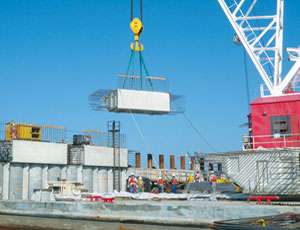...to fill the gaps in between. The inside of the wall is braced by 660 angle-driven, 248-ft-long, 36-in.-dia steel-cylinder batter piles. The assembly makes up the 7,490-ft-long, central part of the barrier. Also included are two sector gates and rock-reinforced concrete T-walls to tie into existing perimeter protections on the shore.

Crews worked two pile drivers on two shifts, six days a week, and drove the last cylinder pile on Oct. 21, two months ahead of schedule, says Col. Robert Sinkler, commander of the Corps’ Hurricane Protection Office in New Orleans. Construction of the gates is progressing as well. Manson on Oct. 24-26 executed a continuous 35-hour, 5,000-cu-yd underwater concrete pour to form a tremie seal in a cofferdam where two 150-ft-wide gates will be installed.
“At peak, Manson had 48 concrete trucks on the water,” says Zilmer, explaining that Manson decided to barge trucks to the pour rather than use transfer buckets. The cofferdam was dewatered the following week, and Manson now is casting gate sills. One gate will be open for vessels this spring. All hydraulics and gates are to be finished in March 2012.
The vertical face of the central cylinder-pile wall now is in place. Sill to be installed as of Dec. 7 are the last 17% of the closure piles, 53% of the batter piles, 81% of the 96-ton, 17-ft long, 12-ft-wide, 6-ft-tall caps and 96% of the parapet wall, which will bring the top of the finished structure to +26 ft, Zilmer says.
Other ongoing work includes grouting between closure and cylinder piles, driving batters, fitting high-density polyethylene sleeves over batters and attaching the caps. “We are placing two caps a day, 12 a week,” says Wayne Jones, TMW project manager. “Everything we do is based on eight; to set two caps, we have to clean out eight piles, set eight cages, concrete-in eight connecting pins and put 3 in. of leveling concrete on top.”
The wall requires a total of 62,000 cu yd of concrete, Zilmer says. At the current use rate of 300 to 400 cu yd per day, the contractor expects to beat the Sept. 1 deadline by delivering 83,000 cu yd cast by August. That will include additional concrete for gates and T-walls.
Except for fishermen, most people the barrier protects probably will never see it. But they’re happy anyway, Hess says. When the last soldier pile was installed, “I had neighbors congratulating me on completion of the barrier,” he says.


Post a comment to this article
Report Abusive Comment